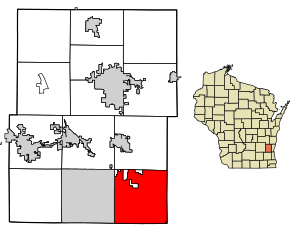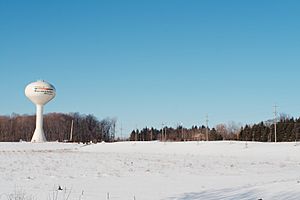Germantown, Wisconsin facts for kids
Quick facts for kids
Germantown
|
|
|---|---|

Location of Germantown in Washington County, Wisconsin.
|
|
| Country | United States |
| State | Wisconsin |
| County | Washington |
| Incorporated | 1927 |
| Area | |
| • Total | 34.40 sq mi (89.09 km2) |
| • Land | 34.37 sq mi (89.03 km2) |
| • Water | 0.02 sq mi (0.06 km2) |
| Population
(20220)
|
|
| • Total | 20,917 |
| ZIP code |
53022
|
| Area code(s) | 262 |
| FIPS code | 55-28875 |
Germantown is a village in Washington County, Wisconsin, United States. In 2020, about 20,917 people lived there. The village is part of the larger Milwaukee area. In 2007, Money Magazine said Germantown was the 30th best place to live in the U.S.
Contents
Geography
Germantown is located in Wisconsin. It covers about 34.45 square miles (89.09 square kilometers). Most of this area is land, with only a small part being water.
Native American Lands
Germantown is on land that was once home to several Native American tribes. These include the Potawatomi, Peoria, Menominee, Miami, and Sioux peoples. This land was given up by the Potawatomi tribe in a treaty signed in 1833.
Climate
Germantown has a climate with warm summers and cold, snowy winters. The hottest temperature ever recorded was 104°F (40°C) in July. The coldest was -40°F (-40°C) in January. The area gets a good amount of rain and snow each year.
| Climate data for Germantown, Wisconsin (1991–2020 normals, extremes 1944–present) | |||||||||||||
|---|---|---|---|---|---|---|---|---|---|---|---|---|---|
| Month | Jan | Feb | Mar | Apr | May | Jun | Jul | Aug | Sep | Oct | Nov | Dec | Year |
| Record high °F (°C) | 58 (14) |
72 (22) |
83 (28) |
89 (32) |
93 (34) |
99 (37) |
104 (40) |
102 (39) |
99 (37) |
89 (32) |
77 (25) |
67 (19) |
104 (40) |
| Mean daily maximum °F (°C) | 27.3 (−2.6) |
30.7 (−0.7) |
41.9 (5.5) |
54.2 (12.3) |
66.3 (19.1) |
76.3 (24.6) |
80.8 (27.1) |
79.1 (26.2) |
72.2 (22.3) |
59.2 (15.1) |
45.1 (7.3) |
33.0 (0.6) |
55.5 (13.1) |
| Daily mean °F (°C) | 19.3 (−7.1) |
22.1 (−5.5) |
32.8 (0.4) |
44.2 (6.8) |
55.6 (13.1) |
65.3 (18.5) |
70.1 (21.2) |
68.4 (20.2) |
61.1 (16.2) |
48.9 (9.4) |
36.4 (2.4) |
25.4 (−3.7) |
45.8 (7.7) |
| Mean daily minimum °F (°C) | 11.3 (−11.5) |
13.5 (−10.3) |
23.7 (−4.6) |
34.2 (1.2) |
44.9 (7.2) |
54.3 (12.4) |
59.5 (15.3) |
57.7 (14.3) |
49.9 (9.9) |
38.7 (3.7) |
27.8 (−2.3) |
17.9 (−7.8) |
36.1 (2.3) |
| Record low °F (°C) | −40 (−40) |
−28 (−33) |
−20 (−29) |
7 (−14) |
20 (−7) |
23 (−5) |
36 (2) |
33 (1) |
22 (−6) |
8 (−13) |
−15 (−26) |
−25 (−32) |
−40 (−40) |
| Average precipitation inches (mm) | 1.57 (40) |
1.44 (37) |
1.90 (48) |
3.84 (98) |
3.95 (100) |
4.37 (111) |
3.92 (100) |
3.80 (97) |
3.22 (82) |
2.64 (67) |
2.00 (51) |
1.73 (44) |
34.38 (873) |
| Average snowfall inches (cm) | 16.5 (42) |
16.0 (41) |
6.5 (17) |
2.0 (5.1) |
0.3 (0.76) |
0.0 (0.0) |
0.0 (0.0) |
0.0 (0.0) |
0.0 (0.0) |
0.3 (0.76) |
2.4 (6.1) |
10.3 (26) |
54.3 (138) |
| Average precipitation days (≥ 0.01 in) | 9.7 | 8.0 | 8.9 | 11.4 | 13.4 | 11.7 | 10.9 | 10.8 | 9.6 | 11.5 | 9.5 | 9.3 | 124.7 |
| Average snowy days (≥ 0.1 in) | 7.0 | 5.5 | 3.5 | 1.1 | 0.0 | 0.0 | 0.0 | 0.0 | 0.0 | 0.2 | 1.9 | 5.5 | 24.7 |
| Source: NOAA | |||||||||||||
History
Early Inhabitants and European Settlement
The land where Germantown now stands was first home to the Potawatomi tribe. In 1833, the Potawatomi gave up this land to the United States government. Many Native people moved west, but some stayed or returned. They were sometimes called "strolling Potawatomi" because they moved around their old lands. Later, many of these Potawatomi formed the Forest County Potawatomi Community in northern Wisconsin.
In the 1840s, many German immigrants came to this area. They came from places like Bavaria and Prussia. Because so many Germans settled here, the area was named "Germantown."
Town and Village Formation
The Wisconsin Territory officially created the Town of Germantown on January 21, 1846. The first town meeting happened on April 7 of that year. The town included several small communities, such as Dheinsville and Rockfield.
In the 1800s and early 1900s, farming was very important to Germantown's economy. Dairy farming was a big part of this. The southern part of Germantown also had a lot of limestone, which was dug up starting in the 1870s. South Germantown grew because it had a train stop, connecting it to other towns.
In 1927, a part of the town became the Village of Germantown. This new village was much smaller than it is today.
World War II Prisoner Camp
During World War II, from 1944 to 1946, there was a prisoner of war camp in Rockfield, a part of Germantown. This camp held about 500 German prisoners of war. Many of these prisoners worked on farms or in local factories, like a pea canning company.
Village Growth
In 1963, the city of Milwaukee took over a small piece of land in Germantown for a landfill. People in Germantown worried that Milwaukee would take more land. To protect itself, the Village of Germantown decided to take over all the smaller communities around it. This made the village much larger, growing to about 24 square miles. Since then, the village has continued to grow, now covering over 34 square miles.
Demographics
| Historical population | |||
|---|---|---|---|
| Census | Pop. | %± | |
| 1930 | 255 | — | |
| 1940 | 292 | 14.5% | |
| 1950 | 357 | 22.3% | |
| 1960 | 622 | 74.2% | |
| 1970 | 6,974 | 1,021.2% | |
| 1980 | 10,729 | 53.8% | |
| 1990 | 13,658 | 27.3% | |
| 2000 | 18,260 | 33.7% | |
| 2010 | 19,749 | 8.2% | |
| 2020 | 20,917 | 5.9% | |
2020 Census Information
In 2020, Germantown had 20,917 people. About 76.7% of homes were owned by the people living in them. The average value of a house was about $274,900. The average income for a household in Germantown was $89,100.
2010 Census Information
In 2010, there were 19,749 people living in Germantown. There were 7,766 households, and 5,501 of these were families. The village had about 573 people per square mile.
Most people in Germantown were White (92.6%). There were also African American (2.2%), Native American (0.2%), and Asian (3.1%) residents. About 2.0% of the population was Hispanic or Latino.
About 35% of households had children under 18. The average household had 2.53 people, and the average family had 3.03 people. The average age in the village was 41.7 years.
Education
The Germantown School District runs the schools in Germantown. As of 2008, about 3,019 students attended schools in the district.
High School
- Germantown High School
Middle School
- Kennedy Middle School
Elementary Schools
- Amy Belle Elementary
- County Line Elementary
- MacArthur Elementary
- Rockfield Elementary
There are also two private schools:
- Bethlehem Lutheran School (North Campus)
- St. Boniface School
Notable people
- Jesse Kremer, a politician and firefighter
- Jacob Leicht, a politician and farmer
- John F. Schwalbach, a politician and businessman
- Jesse Thielke, an Olympic wrestler who competed in the 2016 Summer Olympics
See also
 In Spanish: Germantown (Wisconsin) para niños
In Spanish: Germantown (Wisconsin) para niños



